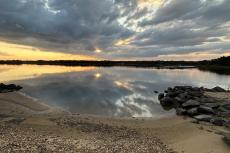Frances Jones was running with her dog Dolly on an empty Bridgehampton beach Wednesday morning when from a distance, she saw something large in the surf. A tail, which at first she thought was thrashing. As she got closer it became clear that she was looking at a whale, getting tossed in the surf — unfortunately, a dead whale.
"I've seen them happily swimming and spouting and blowing, but never dead," she said of the nearly school bus-sized animal.
Rob DiGiovanni, the chief scientist for the Atlantic Marine Conservation Society, performed a necropsy on the whale, a female minke, measuring 26 feet long and weighing nearly 8,000 pounds. The Town of Southampton provided an excavator so he could do the work. He could not determine an exact cause of death, but confirmed the whale didn't die from a vessel strike or entanglement. He sent a sample of its tissue out to test for disease.
Since 2016, minke, humpback, and North Atlantic right whales have been showing up dead with a higher occurrence than scientists would expect. The leading cause of minke whale death is biological, said Mr. DiGiovanni. For humpbacks and right whales, it's vessel strikes and entanglement.
The Bridgehampton whale had no food in its digestive tract. "It had a thin blubber layer; we would consider it underweight. It was severely decomposed," he said.
Mr. DiGiovanni said that when whales die, they sink (except for right whales). As they decompose, they fill with gas and float again before washing ashore, so it's not clear how long ago the whale had been dead.
"To put it in a weird perspective, we had one floating off Montauk that was too far to pull in. So, we put a carcass tag on it and tracked it. It floated for a week before washing up on Block Island."
The whale was buried on the beach late yesterday.
Minke whales are difficult to sight on whale tours because they're small and not as showy as humpbacks. They're one of the smallest of the baleen whales, though still 30 feet when fully grown. "They only come up for a quick breath, so there's not a lot of sightings," said Mr. DiGiovanni.
In 2019, New York State regulations were passed that have helped the menhaden population. "Whales feed on menhaden, so we're seeing more of them from shore," said Mr. DiGiovanni. He's been conducting marine surveys for 30 years. In the beginning, he'd see one or two bait balls offshore. "Now you see large schools of bunker that stretch for extended periods."
"If you were to go to a buffet and they have all the food you want, you're going to stay longer. If they have just one or two things you like, there will be less people that show up. That's one of the things we're trying to address. Are we seeing more animals, or are we having the same amount of animals stay longer causing more sightings, or are we seeing both? There are definitely more sightings. People would say 25 years ago when a whale washed up, 'I didn't know we had whales.' That's not the case anymore."
The top causes of death for whales are vessel strikes, entanglement, ingestion of debris, and then disease, but Mr. DiGiovanni said it's difficult to come up with definitive answers for many. One thing that's clear is that whale strandings are increasing. "Prior to 2007, we would average 133 days between strandings. By 2017 that frequency decreased to 27 days between stranding events. We see 12 to 14 animals per year."
For Ms. Jones, her early morning find was a reminder of a children's book her father wrote for her and her sister Elizabeth. In it, he exits the train at Bridgehampton before they head down to the beach and discover a beached whale. She has the pages of the book framed and hung on a wall in her house. "It's one of my favorite things in the world," she said.
Those who come across a stranded whale or loggerheaded turtle can email reports to [email protected]. "It's a big, recovering ecosystem out there," said Mr. DiGiovanni. "The more information we can get, the better we can understand what drivers are out there and learn how they're impacting whales."




